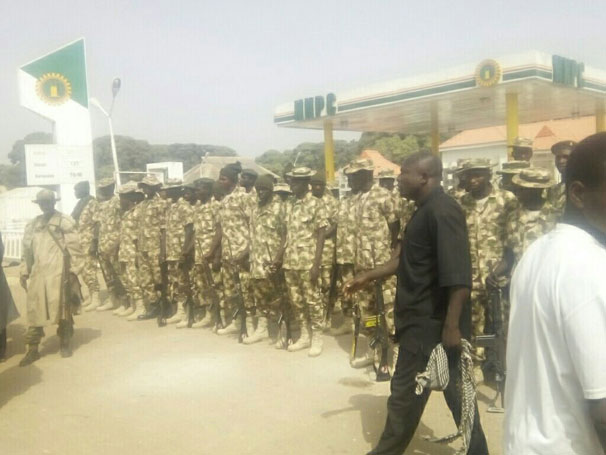
NewsRescue
the Mohammed Lawal Garba chaired Judicial inquiry panel into the Zaria massacre that left hundreds of mostly minority Shia Muslims dead, in its report failed to mention the well known factor that triggered the confrontation.
The report began its “immediate causes” section describing an afternoon road block. The report however failed to state that earlier in the morning as pictures show, the Nigerian army had stationed soldiers in front of the Islamic movement Hussainiyah center. Some accounts mention that at this time the soldiers had already killed 7 members of the movement.

All testimonies and picture and video evidence verify the pre-road block stationing of troops in front of the center with boxes of extra ammunition.
It was this stationing that was alleged to have caused agitation and fear among people attending the flag-hoisting ceremony who compelled the stationed soldiers to move to the NNPC.
The Judicial report stated:
2.2.1 Immediate Causes
Available records before the Commission indicate that the most
immediate cause of the clashes of 12 – 14 December, 2015 between the
Nigerian Army and IMN was the act of the road barricade mounted by
the IMN on a very busy highway leading to PZ junction en route to the
NA Depot at what is popularly referred to as Hussainiyya Baqiyatillah.
This was reportedly on the occasion of the “hoisting of the flag
ceremony” at the venue, which resulted in the ensuing verbal
altercations, the “alleged” assassination attempt on Chief of Army Staff
27 Memo Submitted to the Commission by Prof. Dahiru Yahya, Dated 22 February 2016. pp. 4-5 28 Prof. Baffa Aliyu Umar, The Origin, Ideology, Practices, Transformation And Encounters Of The Islamic Movement In
Nigeria, Commissioned Paper for the Judicial Commission. p. 17
“TOP SECRET”
“TOP SECRET” JUDCOM Page 29 of 193
(COAS), the forceful clearance of the blockade and shootings. The
Commission found that:
a. When the COAS convoy ran into the blockade some NA officers,
the Nigeria Police and other security agents took steps and turns
to persuade the IMN members to allow passage which yielded no
results.
b. It was in evidence from the testimonies of some of the officers and
a video clip29 trying to persuade the IMN to remove the blockade;
that the NA officers noticed that they were being encircled and that
there were suspected gunshots sound heard.
c. Based upon its threat assessment, the NA felt apprehensive of the
safety and security of the COAS and his convoy. Consequently,
they, as the testimony of one officer stated, “shot their way through
the blockade”. This resulted in casualties of 7 deaths and 10
injured IMN members as stated by the Acting Provost Marshal
when testifying under cross examination before the Commission.
d. Following the incidence of the 12th December, 2015 there was a
perceived threat to the breach of law and order by the NA which in
their assessment necessitated the ordering of a C&S operation as
well as the arrest of the IMN leader.
e. The oral order for the Cordon and Search Operation issued by the
GOC 1 Div which led to the deployment of officers and men of the
NA for operational use, was in contravention of the provisions of
Section 8 of the Armed Forces Act, No 24 of 1994 which provides
as follows:
29 See Exhibits 2, 20 and 20 (a-d)
“TOP SECRET”
“TOP SECRET” JUDCOM Page 30 of 193
Operational Use of the Armed Forces
1. The President shall determine the operational use of the
Armed Forces, but may, under general or specific directives,
delegate his responsibility for day to day operational use:
a) of the Armed Forces to the Chief of Defence Staff;
b) of the Army to the Chief of Army Staff;
c) of the Navy to the Chief of Naval Staff; and
d) of the Air Force to the Chief of Air Staff
2. It shall be the duty of the Chief of Defence Staff, Chief of
Army Staff, the Chief of Naval Staff and the Chief of Air Staff,
as the case may be, to comply with any directive given to
them by the President under sub-section 1 of the Section.
3. In this Section, “Operational use of the Armed Forces”
includes the operational use of the Armed Forces in Nigeria
for the purpose of maintaining and securing public safety and
public order.”
f. There is no evidence before the Commission that the order for the
Cordon and Search Operation deploying members of the Armed
Forces for the alleged purpose of maintaining and securing public
safety and peace, was derived from any delegation of authority by
the President and/or the Chief of Army Staff, as provided by these
provisions.
g. In addition, Section 218(1) and (3) of the 1999 Constitution (as
amended) vests power to determine the operational use of the
Armed Forces of the Federation, in the President and the
discretion to, by directions in writing, delegate such power to any
member of the armed forces relating to the operational use of the
armed forces. There was no evidence that there was the requisite
delegation by the President to the Officer who issued the oral order
“TOP SECRET”
“TOP SECRET” JUDCOM Page 31 of 193
for the deployment of the Officers and Men of the Nigerian Army
(N.A) for the C and S operation.




